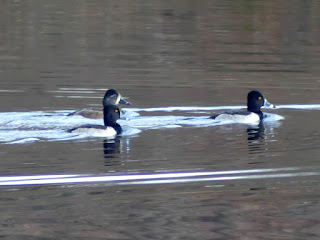Ring-necked Ducks
This was the 2nd picture I got this past season of Ring-necked Ducks. (The 1st picture wasn't a good but you can look at it if you want to.) You might be thinking "I don't see any rings on the necks - this must be a misidentification", buf if you were close enough you would see a ring around the neck (even though it's difficult/impossible to see from a distance). This is certainly one of those instances where the bird got its common name from someone seeing the bird up close, and they almost certainly got that close look because the bird was dead.
I was (mildly) victimized by these ducks being named after such a subtle physical trait. Years ago when I saw them, got some pictures, and attempted to identify them, I got to a webpage listing the names of all the ducks in my area. As I went down the list, I skipped right over the link for Ring-necked Ducks because I felt certain there was no ring around their neck. This led me to erroneously believe that the best fit for "my ducks" was the Lesser Scaup (though I also entertained the Greater Scaup theory too). In my defense, the Cornell Lab of Ornithology does list both scaups as "similar species".
Cornell's webpage also describes the Ring-necked Duck as a medium-sized duck, which surprised me because they're frequently the smallest ducks out on the water. The only ducks I routinely see that are smaller are Wood Ducks and Hooded Mergansers, and they're only slightly smaller than the Ring-necked Ducks. The Ring-necked Ducks achieve their mid-sized status mostly because they really are quite a bit bigger than ducks I see less often, like Buffleheads and the teals. There's reason to consider them medium-sized even though they might be the smallest ducks in the lake.
 |
| November 29, 2022 at the Washington Valley Reservoir Photo 251085902, (c) jpviolette, some rights reserved (CC BY-NC) |



Comments
Post a Comment